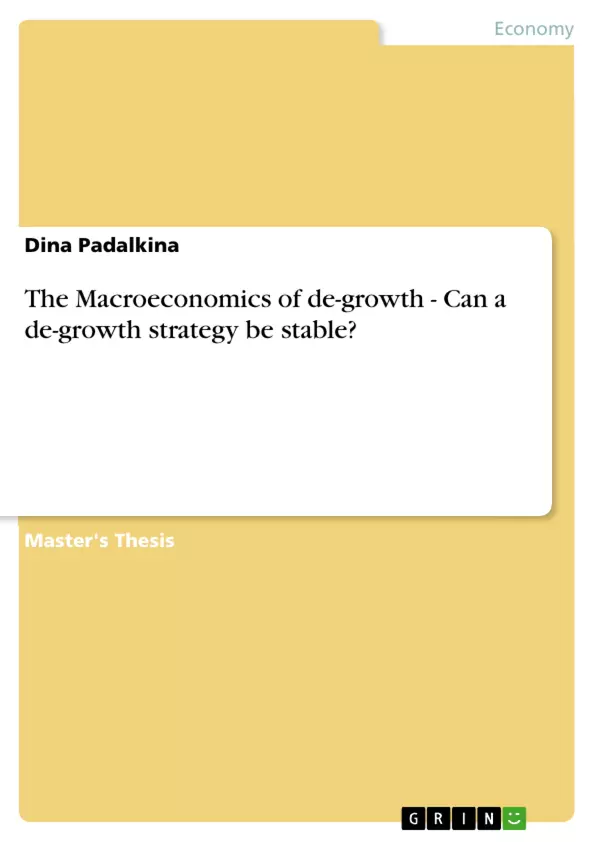This paper examines an alternative strategy for sustainability and economic development
based on de-growth assumptions. This concept is proposed by ecological economists, who
consider there to be a natural limitation on economic growth, imposed by necessary
environmental regulation. Moreover they oppose the neoclassical ideas, which are considered
as pro growth theories, arguing that economic growth itself does not contribute to the social
and economic development, therefore it should not be sustained. Accepting this proposition
the author makes an attempt to verify the feasibility of a de-growth strategy for
macroeconomic stability, applying a post-Keynesian methodology for analysis. The Kaleckian
model is used as the basic approach to derive the model restrictions for the de-growth strategy
that maintains macroeconomic stability. The findings of this paper will provide policy
recommendations to sustain macroeconomic stability, while taking full account of the degrowth
assumptions.
Inhaltsverzeichnis (Table of Contents)
- Introduction
- From growth critics to de-growth
- Historical overview of the economic growth theories and environmental limits
- Formation of the de-growth concept from the environmental perspective
- Economics of the concepts for sustainability
- Neoclassical environmental approach to sustainability
- Ecological approach to sustainability
- The Steady-State economy
- The LowGrow model
- Post-Keynesian approach to sustainability
- De-growth modelling in the Post-Keynesian economic framework
- Kaleckian model and its extensions
- Dutt-Amadeo model and Bhaduri-Marglin extension
- The impact of financialisation
- The de-growth assumptions in the Kaleckian model
- Zero growth assumption in the Dutt-Amadeo, Bhaduri-Marglin, and market financialisation framework
- Governmental intervention in the economy
- Evaluation of the functioning model with the given notion of de-growth
- Kaleckian model and its extensions
- Policy recommendations
Zielsetzung und Themenschwerpunkte (Objectives and Key Themes)
This paper aims to analyze the feasibility of a de-growth strategy for achieving macroeconomic stability within a post-Keynesian framework. The study examines whether the de-growth strategy can be implemented and sustained within the current economic system while addressing environmental concerns.- The concept of de-growth as an alternative to traditional economic growth models.
- The relationship between economic growth, environmental limits, and sustainability.
- The potential for a de-growth strategy to achieve macroeconomic stability and address environmental issues.
- The role of government intervention and policy recommendations for implementing a de-growth strategy.
- The use of a post-Keynesian approach and the Kaleckian model to analyze the macroeconomic implications of de-growth.
Zusammenfassung der Kapitel (Chapter Summaries)
- Introduction: The paper introduces the concept of de-growth as a response to environmental degradation and explores its relevance in light of the 2008-2009 financial crisis. It presents the main research question, which focuses on the feasibility of achieving macroeconomic stability within a de-growth framework. The author highlights the use of a post-Keynesian approach with the Kaleckian model as the foundation for the analysis.
- From growth critics to de-growth: This chapter provides a historical overview of economic growth theories and their limitations from an environmental perspective. It then delves into the formation of the de-growth concept, emphasizing the need to address the unsustainable nature of conventional growth models.
- Economics of the concepts for sustainability: Chapter 3 analyzes various approaches to sustainability, examining both the neoclassical and ecological perspectives. It highlights the key elements of the Steady-State economy and the LowGrow model, while also discussing the role of the post-Keynesian approach in achieving sustainable economic development.
- De-growth modelling in the Post-Keynesian economic framework: This chapter explores the integration of de-growth assumptions into the Kaleckian model, utilizing extensions like the Dutt-Amadeo and Bhaduri-Marglin models. It examines the impact of financialization and the role of governmental intervention in implementing a de-growth strategy within this framework.
- Policy recommendations: This chapter presents potential policy recommendations that could support the implementation of a de-growth strategy. It identifies specific measures to address the economic and environmental challenges associated with shifting towards a zero-growth paradigm.
Schlüsselwörter (Keywords)
The research focuses on the macroeconomic implications of a de-growth strategy. This involves examining the relationship between economic growth, environmental constraints, and sustainability. The paper explores the potential for a de-growth approach to achieve macroeconomic stability and address environmental issues. Key terms and concepts include: de-growth, sustainability, consumption and production patterns, ecological and environmental economics, post-Keynesian economics, Kaleckian model, taxation, distribution policy, and regulation.- Quote paper
- Dina Padalkina (Author), 2012, The Macroeconomics of de-growth - Can a de-growth strategy be stable?, Munich, GRIN Verlag, https://www.grin.com/document/191185



